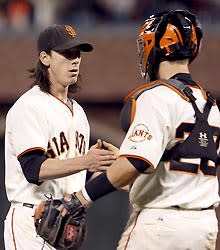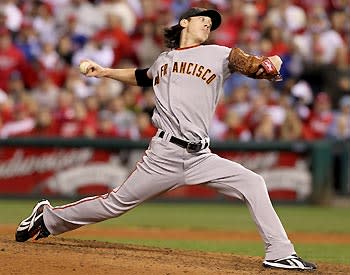Lincecum found himself before letting in Posey
SAN FRANCISCO – A month ago, Tim Lincecum’s(notes) fourth major league season was nearing an end.
For the first time in three, he would not be the National League’s best pitcher. In fact, he’d spent a good part of the season separating the good from the bad, seeking his familiar brilliance and settling for something – anything – close.
He’d lost another inch or so on his fastball, re-gripped his slider, dissected it all with his dad, watched video until his eyes swelled, then read and reread the text messages of encouragement from his former catcher, Bengie Molina(notes).
By late September, he’d begun to loosen the tangle of brain and body, of hesitation and commitment. As he stood on the doorstep of the first postseason starts of his life, he’d finessed seven more innings against the Arizona Diamondbacks, putting changeups where fastballs might have been and sliders where fastballs absolutely had to have been. He struck out 11 in seven innings.
Asked why he’d turned away from his fastball, how he knew when to throw what, Lincecum crinkled his brow and shrugged.
“That’s what Buster called for,” he said.
Buster Posey(notes) turned 23 in March. He became a full-time big leaguer two months later and the San Francisco Giants’ regular catcher a month after that. He was gifted, everyone agreed.
He also was replacing Molina, the veteran who had nursed a young rotation into one of the better staffs in the game and caught nearly 90 percent of Lincecum’s innings before he – Molina – was traded to the Texas Rangers in early July.
So it was Molina who would type messages to Lincecum during the hardball tangle that followed, urging Lincecum to believe in himself, to remember who he was and what he’d done. And it was Posey who would catch Lincecum’s games, some of them great, others dishearteningly messy and imprecise.
Lincecum’s instinct was to trust the fingers and the mitt, even during the Cy Young years. Particularly in the Cy Young years.
“I think he got that from Bengie,” said Eli Whiteside(notes), the Giants’ backup catcher. “Bengie’s one of the best in the game at doing it.”
Then along came Posey, learning a new staff and a new league, and yet so bright as to be almost born into it. The coaches talked about his feel for the game like it was unique, like he knew where the game would go before it was even leaning in that direction.
But Lincecum would be a challenge. His mechanics, drafted in his backyard when he was 7, are his alone. His fastball, once so dominant for its velocity and movement, was changing. His changeup, one of the better pitches in the league, remained, but his curveball – once flippy and inconsistent – was morphing into a slider. He was throwing more two-seam fastballs.
Lincecum was evolving and Posey was trying to keep up. Meantime, August arrived, and the great Lincecum couldn’t stop losing. He lost five in the month alone, when his ERA was 7.82.
“He wasn’t himself,” Giants pitching coach Dave Righetti said. “That’s not easy for a catcher, either. Buster is looking for other stuff to come out. We told him, ‘Don’t catch what you think he’s going to throw. Catch what he is throwing. He needs your help.’ ”
Posey had 10 other Giants pitchers to think about as well, not to mention the dozens of opposing ones he was trying to hit. One by one, the pitchers in his clubhouse learned to think along with and trust the young catcher.
Closer Brian Wilson(notes) said it happened for him, “Instantly.”
Soon after, Matt Cain(notes) revealed he’d been won over.
“I think that helped,” Righetti said.
A connection with Lincecum took longer.
“For me, I don’t know when that time was,” Posey said. “I’m sure it took everybody a little while. It’s part of it.
“It might have taken us a little longer. His stuff is so different than everybody else’s. It took me a while to learn how to catch him. There’s tons of deception. The fastball, sometimes it cuts, sometimes it sinks. I don’t even know sometimes.”
Maybe Lincecum had to figure himself out first, then give it away to his catcher. Maybe they happened to arrive in the same place at the same time. In nine starts since Sept. 1, Lincecum is 7-2 and his ERA is 1.69. He’s struck out 81 and walked 13.
Once, he reinvented himself over a couple months. Now he reinvents himself from inning to inning. He killed the Diamondbacks that night with changeups, and in his next start – Game 1 of the division series against the Atlanta Braves – won with sliders. Now he takes it as it comes, whatever’s there for him.
“You get stuck into patterns or routines or kind of comfortable things where I had Bengie back there every game … taking care of the stuff that I didn’t have to or didn’t need to,” Lincecum said. “You know, and it’s kind of tough to get on the same page with a new guy coming up.
“But, he did it quickly. He helped me get out of my ruts, just gave me a lot of feedback on my pitches, telling me to still be confident, that I’m here for a reason. It came around a little bit later than we hoped, but we figured it out.”
Now they’ll start Game 1 of the World Series together, and combine on the first World Series pitch that’s been thrown in these parts in eight years. You can be sure it’ll be whatever Buster calls for.


